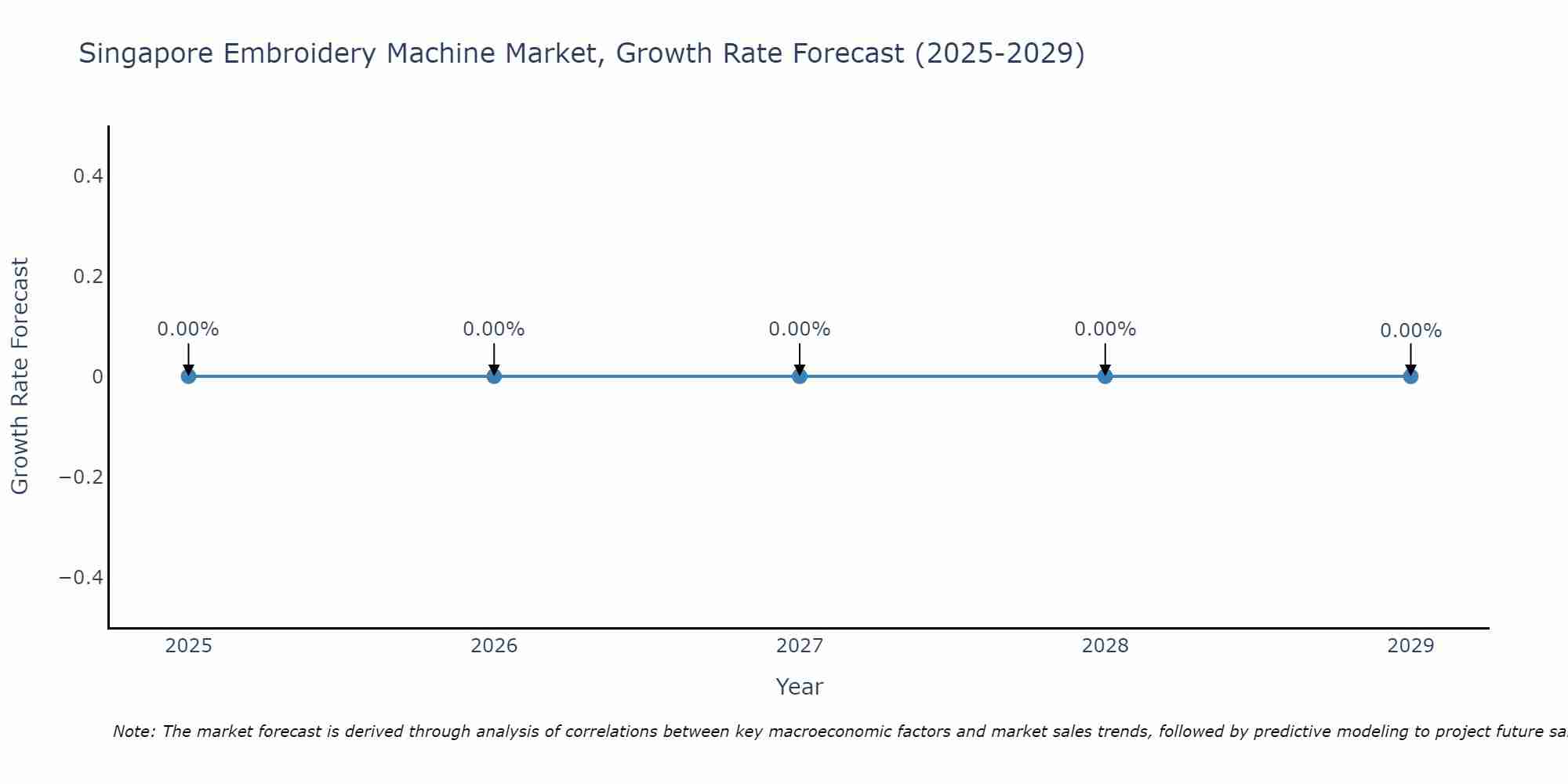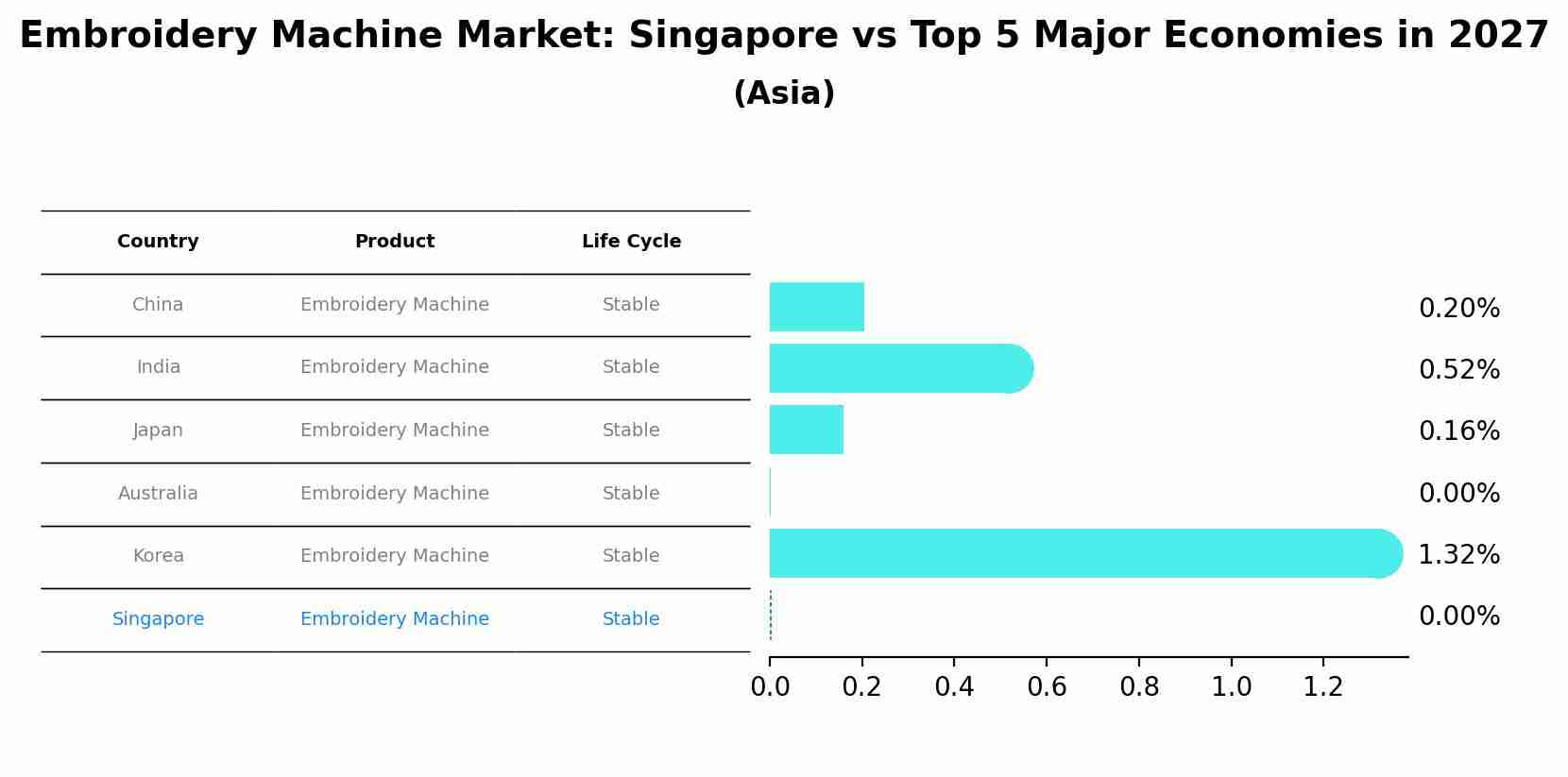Singapore Embroidery Machine Market (2026-2032) | Industry, Growth, Share, Forecast, Trends, Revenue, Companies, Size, Value, Analysis & Outlook
Market Forecast By Product Type (Single Head, Multi Head), By Applications (Household, Commercial, Industrial) And Competitive Landscape
| Product Code: ETC063166 | Publication Date: Jul 2023 | Updated Date: Dec 2025 | Product Type: Report | |
| Publisher: 6Wresearch | Author: Ravi Bhandari | No. of Pages: 70 | No. of Figures: 35 | No. of Tables: 5 |
Singapore Embroidery Machine Market Size Growth Rate
The Singapore Embroidery Machine Market is projected to witness mixed growth rate patterns during 2025 to 2029. The growth rate begins at 0.00% in 2025, climbs to a high of 0.00% in 2027, and moderates to 0.00% by 2029.

Embroidery Machine Market: Singapore vs Top 5 Major Economies in 2027 (Asia)
In the Asia region, the Embroidery Machine market in Singapore is projected to expand at a stable growth rate of 0.00% by 2027. The largest economy is China, followed by India, Japan, Australia and South Korea.

Singapore Embroidery Machine Market Synopsis
The Singapore Embroidery Machine market is projected to register a CAGR of 4.6% during the forecast period (2026-2032). There has been an increase in demand for embroidery machines from various sectors, such as apparel manufacturing, home d?cor and accessories, interior design and furnishings, ETC, due to its easy usage and flexible operation. Moreover, with advancements in technology, embroidery machines are undergoing dynamic shifts that open new opportunities for improvement in product quality and efficiency. The increasing preference towards luxury textile items is expected to further trigger the growth of the market over the forthcoming years.
Market Drivers
The growing consumption of consumer durables across diverse end user industries is driving the demand for advanced embroidery machines in Singapore. In addition to this, favorable government initiatives aimed at promoting business activities through industrial parks & zones have enabled manufacturers to set up their facilities effectively within short timeframes which has further driven the sales of these products on a large scale. Furthermore, rising disposable incomes among citizens combined with consumer inclination towards fashion trends as well as unique designs are some other factors propelling growth of this industry sector significantly.
Market challenges
High cost associated with researching & developing innovative embroidery machine models can hinder market growth prospects over near future.Also, lack of availability skilled workers capable enough to operate these sophisticated machines efficiently might hamper industry outlook during forecast timeline.
Key players
Brother International Corporation (Japan), Janome Sewing Machine Co Ltd (Japan), Tajima Group Inc (Japan) SINGER Corporation(US), SWF East KCS International Inc(US ), ZSK Stickmaschinen GmbH&CoKG(Germany) MURATA MACHINERY LTD.(Japan) Barudan America Inc.(US ), Happy Enterprises Co Ltd.(Taiwan ).
Key Attractiveness of the Report
- 10 Years of Market Numbers.
- Historical Data Starting from 2022 to 2025.
- Base Year: 2025
- Forecast Data until 2032.
- Key Performance Indicators Impacting the market.
- Major Upcoming Developments and Projects.
Key Highlights of the Report:
- Singapore Embroidery Machine Market Outlook
- Market Size of Singapore Embroidery Machine Market, 2025
- Forecast of Singapore Embroidery Machine Market, 2032
- Historical Data and Forecast of Singapore Embroidery Machine Revenues & Volume for the Period 2022-2032
- Singapore Embroidery Machine Market Trend Evolution
- Singapore Embroidery Machine Market Drivers and Challenges
- Singapore Embroidery Machine Price Trends
- Singapore Embroidery Machine Porter's Five Forces
- Singapore Embroidery Machine Industry Life Cycle
- Historical Data and Forecast of Singapore Embroidery Machine Market Revenues & Volume By Product Type for the Period 2022-2032
- Historical Data and Forecast of Singapore Embroidery Machine Market Revenues & Volume By Single Head for the Period 2022-2032
- Historical Data and Forecast of Singapore Embroidery Machine Market Revenues & Volume By Multi Head for the Period 2022-2032
- Historical Data and Forecast of Singapore Embroidery Machine Market Revenues & Volume By Applications for the Period 2022-2032
- Historical Data and Forecast of Singapore Embroidery Machine Market Revenues & Volume By Household for the Period 2022-2032
- Historical Data and Forecast of Singapore Embroidery Machine Market Revenues & Volume By Commercial for the Period 2022-2032
- Historical Data and Forecast of Singapore Embroidery Machine Market Revenues & Volume By Industrial for the Period 2022-2032
- Singapore Embroidery Machine Import Export Trade Statistics
- Market Opportunity Assessment By Product Type
- Market Opportunity Assessment By Applications
- Singapore Embroidery Machine Top Companies Market Share
- Singapore Embroidery Machine Competitive Benchmarking By Technical and Operational Parameters
- Singapore Embroidery Machine Company Profiles
- Singapore Embroidery Machine Key Strategic Recommendations
Frequently Asked Questions About the Market Study (FAQs):
| 1 Executive Summary |
| 2 Introduction |
| 2.1 Key Highlights of the Report |
| 2.2 Report Description |
| 2.3 Market Scope & Segmentation |
| 2.4 Research Methodology |
| 2.5 Assumptions |
| 3 Singapore Embroidery Machine Market Overview |
| 3.1 Singapore Country Macro Economic Indicators |
| 3.2 Singapore Embroidery Machine Market Revenues & Volume, 2022 & 2032F |
| 3.3 Singapore Embroidery Machine Market - Industry Life Cycle |
| 3.4 Singapore Embroidery Machine Market - Porter's Five Forces |
| 3.5 Singapore Embroidery Machine Market Revenues & Volume Share, By Product Type, 2022 & 2032F |
| 3.6 Singapore Embroidery Machine Market Revenues & Volume Share, By Applications, 2022 & 2032F |
| 4 Singapore Embroidery Machine Market Dynamics |
| 4.1 Impact Analysis |
| 4.2 Market Drivers |
| 4.3 Market Restraints |
| 5 Singapore Embroidery Machine Market Trends |
| 6 Singapore Embroidery Machine Market, By Types |
| 6.1 Singapore Embroidery Machine Market, By Product Type |
| 6.1.1 Overview and Analysis |
| 6.1.2 Singapore Embroidery Machine Market Revenues & Volume, By Product Type, 2022-2032F |
| 6.1.3 Singapore Embroidery Machine Market Revenues & Volume, By Single Head, 2022-2032F |
| 6.1.4 Singapore Embroidery Machine Market Revenues & Volume, By Multi Head, 2022-2032F |
| 6.2 Singapore Embroidery Machine Market, By Applications |
| 6.2.1 Overview and Analysis |
| 6.2.2 Singapore Embroidery Machine Market Revenues & Volume, By Household, 2022-2032F |
| 6.2.3 Singapore Embroidery Machine Market Revenues & Volume, By Commercial, 2022-2032F |
| 6.2.4 Singapore Embroidery Machine Market Revenues & Volume, By Industrial, 2022-2032F |
| 7 Singapore Embroidery Machine Market Import-Export Trade Statistics |
| 7.1 Singapore Embroidery Machine Market Export to Major Countries |
| 7.2 Singapore Embroidery Machine Market Imports from Major Countries |
| 8 Singapore Embroidery Machine Market Key Performance Indicators |
| 9 Singapore Embroidery Machine Market - Opportunity Assessment |
| 9.1 Singapore Embroidery Machine Market Opportunity Assessment, By Product Type, 2022 & 2032F |
| 9.2 Singapore Embroidery Machine Market Opportunity Assessment, By Applications, 2022 & 2032F |
| 10 Singapore Embroidery Machine Market - Competitive Landscape |
| 10.1 Singapore Embroidery Machine Market Revenue Share, By Companies, 2025 |
| 10.2 Singapore Embroidery Machine Market Competitive Benchmarking, By Operating and Technical Parameters |
| 11 Company Profiles |
| 12 Recommendations |
| 13 Disclaimer |
- Single User License$ 1,995
- Department License$ 2,400
- Site License$ 3,120
- Global License$ 3,795
Search
Thought Leadership and Analyst Meet
Our Clients
Related Reports
- Afghanistan Apparel Market (2026-2032) | Growth, Outlook, Industry, Segmentation, Forecast, Size, Companies, Trends, Value, Share, Analysis & Revenue
- Canada Oil and Gas Market (2026-2032) | Share, Segmentation, Value, Industry, Trends, Forecast, Analysis, Size & Revenue, Growth, Competitive Landscape, Outlook, Companies
- Germany Breakfast Food Market (2026-2032) | Industry, Share, Growth, Size, Companies, Value, Analysis, Revenue, Trends, Forecast & Outlook
- Australia Briquette Market (2025-2031) | Growth, Size, Revenue, Forecast, Analysis, Trends, Value, Share, Industry & Companies
- Vietnam System Integrator Market (2025-2031) | Size, Companies, Analysis, Industry, Value, Forecast, Growth, Trends, Revenue & Share
- ASEAN and Thailand Brain Health Supplements Market (2025-2031) | Strategy, Consumer Insights, Analysis, Investment Trends, Opportunities, Growth, Size, Share, Industry, Revenue, Segments, Value, Segmentation, Supply, Forecast, Restraints, Outlook, Competition, Drivers, Trends, Demand, Pricing Analysis, Competitive, Strategic Insights, Companies, Challenges
- ASEAN Bearings Market (2025-2031) | Strategy, Consumer Insights, Analysis, Investment Trends, Opportunities, Growth, Size, Share, Industry, Revenue, Segments, Value, Segmentation, Supply, Forecast, Restraints, Outlook, Competition, Drivers, Trends, Demand, Pricing Analysis, Competitive, Strategic Insights, Companies, Challenges
- Europe Flooring Market (2025-2031) | Outlook, Share, Industry, Trends, Forecast, Companies, Revenue, Size, Analysis, Growth & Value
- Saudi Arabia Manlift Market (2025-2031) | Outlook, Size, Growth, Trends, Companies, Industry, Revenue, Value, Share, Forecast & Analysis
- Uganda Excavator, Crane, and Wheel Loaders Market (2025-2031) | Strategy, Consumer Insights, Analysis, Investment Trends, Opportunities, Growth, Size, Share, Industry, Revenue, Segments, Value, Segmentation, Supply, Forecast, Restraints, Outlook, Competition, Drivers, Trends, Demand, Pricing Analysis, Competitive, Strategic Insights, Companies, Challenges
Industry Events and Analyst Meet
Whitepaper
- Middle East & Africa Commercial Security Market Click here to view more.
- Middle East & Africa Fire Safety Systems & Equipment Market Click here to view more.
- GCC Drone Market Click here to view more.
- Middle East Lighting Fixture Market Click here to view more.
- GCC Physical & Perimeter Security Market Click here to view more.
6WResearch In News
- Doha a strategic location for EV manufacturing hub: IPA Qatar
- Demand for luxury TVs surging in the GCC, says Samsung
- Empowering Growth: The Thriving Journey of Bangladesh’s Cable Industry
- Demand for luxury TVs surging in the GCC, says Samsung
- Video call with a traditional healer? Once unthinkable, it’s now common in South Africa
- Intelligent Buildings To Smooth GCC’s Path To Net Zero


















